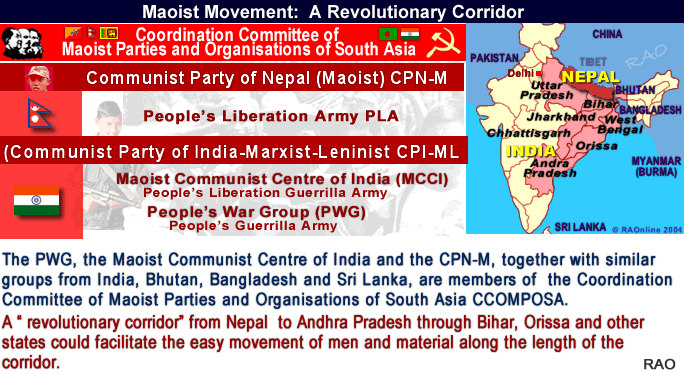|
| War
in Nepal: Facts on Maoists |
|
|
| Maoists'
revolutionary zone |
| Trying
to establish a "revolutionary corridor" |
 |
The
Communist Party of Nepal (Maoist) and newly formed Communist Party of India
(Maoist-Leninist) CPI-ML, a merger between the former Maoist Communist
Centre of India (MCCI) and the People's War Group (PWG). The new party
want to extend the close collaboration with the Communist Party of Nepal
(Maoist).
The
fact is that all Maoist rebels and parties, including People's War Group
(PWG) and Maoist Communist Center (MCC) had merged to form a new outfit
namely Communist Party of India-Maoist (CPI-M) on October 15, 2004.
Muppala Lakshman Rao alias Ganapathi Rao has recently been elected its
Secretary. They have agreed to an international proposal to develop a Red
Zone (RZ) from Nepal to Sri Lanka.
The
two Communist Indian groups initiated moves to enxtend their areas of influence.
The influence of MCCI is mainly confined to Bihar and Jharkhand. But influence
extends to places as far as Andhra Pradesh. The Indian State of Andhra
Pradesh is the stronghold of PWG. The PWG Naxalites have been on an expansion
spree for the past over two years and have gained a varying degree of presence
- intense to moderate - in parts of 12 Indian States.
CPN-M
and PWG, together with 10 other fraternal rebel outfits from South Asia
(India, Bangladesh and Sri Lanka), have formed in July 2001 what is known
as the Coordination Committee of Maoist Parties and Organisations of
South Asia (CCOMPOSA).
| Maoist
leaders of Nepal and India Issued a Joint Statement |
 |
Chairman
of Communist Party of Nepal (Maoist) comrade Prachanda and General Secretary
Communist party of India (Maoist) comrade Ganapathy have issued a joint
statement on September 02, 2005. The two top leadersconfirmed the long
Red Corridor of armed struggle stretching from the Base Areas in Nepal
up to the guerrilla zones of Andhra Pradesh or the so-called Compact Revolutionary
Zone. The two leaders in their statement have condemned the 'fascist attacks
of feudal tyrant Gyanendra upon the Revolutionary People of Nepal' and
of 'Indian ruling classes on the revolutionary leaders & masses of
India.'
Source:
Krishna Sen News
top
| Nepali
Maoists in tough with Indian Maoist groups |
 |
Intelligence
agencies believe that People's War Group (PWG) along with the Maoist
Communist Centre of India (MCCI), now formed together the new Communist
Party of India (Marxist-Leninist-Maoist) and other revolutionary groups
have tied up with Maoist insurgents in Nepal to carve out a Compact
Revolutionary Zone, including Bihar, Jharkhand, Orissa, Chhattisgarh
and Andhra Pradesh. While police have no evidence of the PWG receiving
arms from Nepali Maoists, they said the groups were in touch to implement
their plans to carve out a special zone.
The
Maoists of India and Nepal have also begun joint operations. The Nepalese
Maoists and their Indian sympathizers and counterparts, Naxalites, have
made the Indian and Nepalese Terai region a base of opertion. Sources say
that Sri Lanka's Liberation Tigers of Tamil Eelam (LTTE) and French Maoists
would provide full support to the Indian and Nepalese Maoists and Indian
Maoists would provide shelter and training camps to Nepal's Maoists.
Maoists
have a presence in about 22 districts of Bihar as well as in the neighbouring
state of Jharkhand. Analysts say that they operate in 182 districts in
India, mainly in the states of Jharkhand, Bihar, Andhra Pradesh, Chhattisgarh,
Madhya Pradesh, Maharashtra and West Bengal. The Indian Maoist rebels say
they are fighting for the rights of poor peasants and landless workers.
top
| Maoists
vow to make S Asia 'flaming field' |
 |
A
South Asian regional grouping of Maoist parties, of which the Communist
Party of Nepal-Maoist (CPN-M) is a founding member, has in its recently
concluded meeting vowed to "advance revolutions for the seizure of power
by armed force".
The
Fourth Conference of the Coordination Committee of Maoist Parties and organisations
of South Asia (CCOMPOSA) held in August in an undisclosed location in the
region has also vowed to "deepen and extend the links between genuine Maoists
of the region". This was stated in the political resolution adopted by
the conference.
Contrary
to what they have agreed with the government on the road to peace, Nepali
Maoists - in the joint resolution - have vowed together with their counterparts
in the region to "turn South Asia into a flaming field of Maoist revolutions".
Source:
Kantipur Online, 2006
|


![]()
![]()



